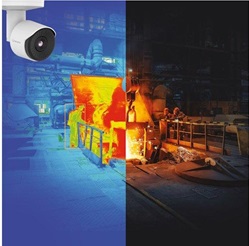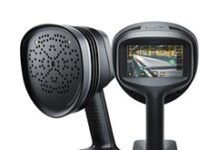
Hanwha Vision, the global vision solution provider, has launched its AI-based high-performance radiometric thermal camera range. These compact cameras meet the needs of customers requiring precise temperature measurements, from −40°C to 550°C, in addition to security and surveillance functions, making them ideal for industrial applications (manufacturing, utilities and energy) as well as airports, shipping and mining industries.
Models in the range include the 8fps versions TNO-C3012TRA/22TRA/32TRA and 30fps versions TNO-C3010TRA/20TRA/30TRA.
Integrating AI into radiometric thermal cameras greatly enhances the monitoring of scenes in demanding visibility and conditions. These latest cameras accurately classify people and vehicles, even in challenging weather (fog, rain, snow) or difficult lighting conditions, for example, complete darkness, or backlight.
This enables operators to proactively protect people and assets, control access to a site, prevent accidents, and monitor for temperature changes in hazardous areas. Hanwha Vision’s radiometric thermal cameras have an expansive temperature detection range of −40°C to 550°C, with a high degree of accuracy that makes them ideal for industrial applications, such as factories and battery rooms, where temperature control is paramount.
The cameras can convey vital data on temperature changes back to operators, warning them of potential problems with industrial machinery and materials, such as ageing parts and equipment failure.
By addressing any issues flagged by the cameras, operators can minimise unexpected downtime, improve safety and boost maintenance efficiency. By leveraging this pioneering technology, the need for on-site inspections can be reduced with processes proactively monitored.
The 17 µm pixel size and improved sensitivity, 30 mK Noise Equivalent Temperature Detection (NETD), enhance thermal discrimination in challenging scenes with low contrast, such as high-temperature objects in a high-temperature environment, or low-temperature objects in a low-temperature environment.
The cameras are equipped with QVGA resolution (384×288) and wide-angle lenses (HFoV 90°/60°/37.9°), making them ideally suited for short-to-medium range monitoring applications. The cameras can capture clear and detailed images for the AI to analyse accurately, even in challenging lighting conditions.
Installers will benefit from an easy installation process as the cameras are lightweight, at just 1.7kg which is 45% lighter than the closest comparative model, and compact, in a bullet camera casing. At just 233.5mm in length, they are also more than 40% smaller than the closest comparative model.
The 8fps cameras also fall outside of the Wassenaar Arrangement, an export control regime that governs specific goods including cameras with frame rates over 9fps. This makes exporting and importing them simpler, enabling a quicker delivery time.











